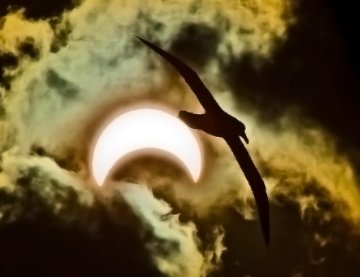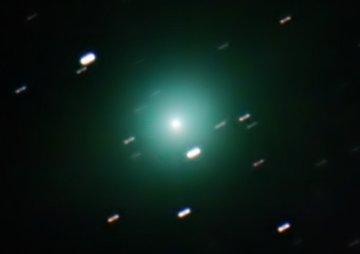| NASA NEEDS YOU: NASA is forming a mini-Deep Space Network to monitor the "Dark Side" of the Sun. Ham radio clubs with access to 10m dish antennas can join the effort. Read the full story from Science@NASA. If you're an experienced ham with an interest in participating, please contact the STEREO team for technical details. SOLAR ECLIPSE: When the sun rose yesterday over Gough Island in the remote South Atlantic Ocean, only half of the sun actually appeared. The rest was hidden behind the Moon: 
Chantal Steyn took the picture using a Nikon D300. "It was amazing to see the eclipsed sun rise over the ocean waves," she says. "At one point the crescent narrowed to just 20%. Gough Island was a good location for viewing the eclipse despite the cloud cover." Most of the Jan. 26th eclipse took place over remote places like Gough Island, inhabited mainly by sea birds and transient photographers. A few exceptions: South Africa, Indonesia and the Philippines. Observers there were favored with some very nice crescent suns and even "rings of fire." Browse the gallery for examples: UPDATED: Jan. 26 Solar Eclipse Gallery
[Submit your photos] [Animated eclipse maps] THE GREEN COMET COMETH: The first thing that strikes most observers when they see Comet Lulin is the color: It's green! Astrophotographer Günther Strauch recorded the hue on Jan. 26th from his backyard observatory in Borken, Germany: 
"This is a composite of 11 half-minute exposures I made using a Canon EOS 40D and a 16-inch Meade telescope," he says. Green is a sign of poisonous gas. The comet's atmosphere contains toxic cyanogen (CN) and diatomic carbon (C2). Both substances glow green when illuminated by sunlight via a process called "resonant fluorescence." In 1910, many people panicked when astronomers revealed Earth would pass through the cyanogen-rich tail of Comet Halley. False alarm: The wispy tail of the comet couldn't penetrate Earth's dense atmosphere; even it if had penetrated, there wasn't enough cyanogen to cause real trouble. Comet Lulin will cause even less trouble than Halley did. At closest approach on Feb. 24, 2009, Lulin will stop 38 million miles short of Earth, a distant fuzzball easily seen in binoculars, possibly visible to the unaided eye, utterly harmless. Stay tuned. Comet Lulin Photo Gallery
[Comet Hunter telescope] [sky map] [ephemeris]
Explore the Sunspot Cycle
Recent Fireballs: Jan. 23, Jan. 17, Dec. 29 | 
